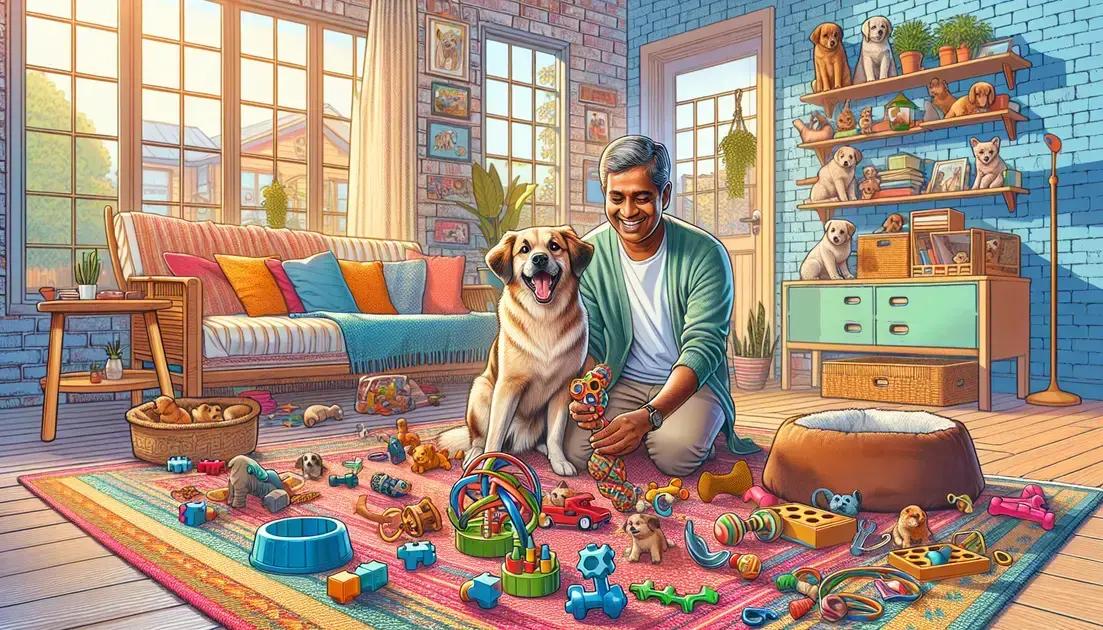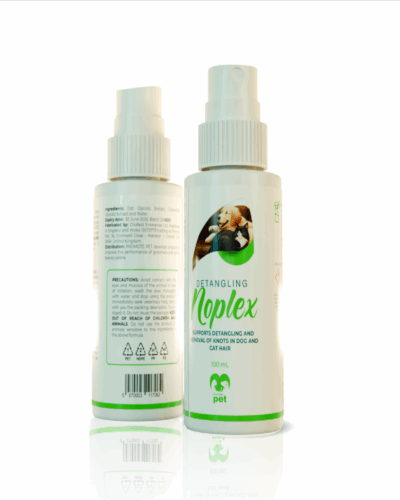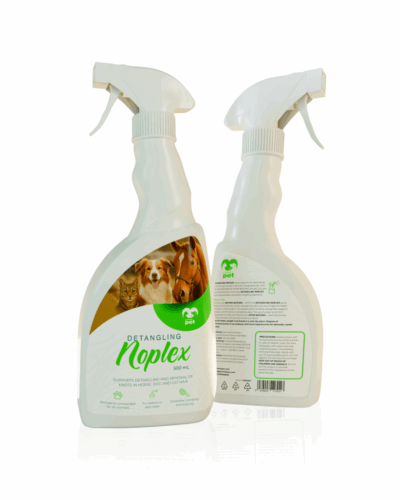Free delivery for orders over £45

The Benefits of Interactive Toys for Dogs
Table of Contents
Keeping your dog entertained and mentally stimulated is crucial for their overall health and happiness. Interactive dog toys are a fantastic way to engage your furry friend, especially when you’re looking to enhance dog playtime tips and provide mental stimulation for dogs. Whether it’s puzzling toys or simply playing a game of fetch, the right toys can make a world of difference. Explore our guide to discover innovative tips and the top toys that cater to your dog’s needs.
Why Interactive Toys Are Essential
Dogs need both physical and mental stimulation to live healthy and fulfilling lives. Interactive toys are crucial because they cater to these needs by providing a challenge that stimulates a dog’s mind and encourages physical activity. These toys often include puzzles, treat dispensers, or elements that respond to a dog’s actions, offering a dynamic play experience.
When dogs engage with interactive toys, they use problem-solving skills that keep their minds sharp. This type of mental exercise helps to prevent boredom and the unwanted behaviours that can arise from it, such as chewing furniture or excessive barking. Interactive toys turn play into a rewarding activity for dogs, offering a satisfaction that extends beyond simple physical exertion.
Moreover, interactive play helps strengthen the bond between dogs and their owners. Playing with your dog using these toys creates opportunities for positive reinforcement and shared experiences, fostering a deeper connection. It also allows owners to observe and understand their pet’s preferences and behavioural cues better.
Interactive toys can also help in training and managing behavioural issues. For instance, a toy that requires a dog to figure out how to dispense a treat can aid in teaching patience and focus. Toys that involve fetch or tug-of-war can reinforce commands while promoting exercise. Therefore, these toys are invaluable tools in a dog’s development and overall well-being.
Top Interactive Toys for Dogs
When choosing interactive toys for your dog, it’s essential to consider those that stimulate both the mind and body. Not only do these toys provide entertainment, but they also help in reducing unwanted behaviours such as barking and chewing. Puzzle toys that dispense treats are fantastic for keeping your dog’s brain engaged. Brands like KONG and Nina Ottosson offer a variety of engaging puzzles that challenge your pet’s problem-solving skills.
Another great option is tug toys. These toys are excellent for energetic dogs who enjoy a good pull. Tug toys strengthen your bond with your pet while also providing a healthy outlet for their energy. Consider using rubber or rope material for durability. Advanced options like interactive ball launchers offer a fun way for dogs to play without constant human interaction. These devices can throw balls at different distances, keeping your dog entertained and physically active.
Chew toys made of natural rubber or nylon are ideal for satisfying a dog’s natural chewing instincts. These toys can keep your dog’s teeth clean and prevent boredom. Look for products that have a variety of textures to provide extra stimulation. Finally, consider subscribing to a dog toy box service like BarkBox which sends monthly new toys and treats curated for your dog’s specific needs and preferences.
Creating a Dog-Friendly Play Environment
Ensuring your canine companion has a space dedicated to fun and safety is crucial for enhancing their playtime experience. Creating a dog-friendly play environment involves more than just having toys scattered about; it requires thoughtful planning and setup. Begin by designating an area within your home or yard that will serve as the primary play space, ensuring it’s free from hazards such as sharp objects or delicate items.
Incorporate interactive toys into this environment, as they offer multiple benefits beyond mere entertainment. These toys, such as puzzle feeders and treat-dispensing balls, provide mental stimulation that helps reduce anxiety and prevents destructive behaviours. While designing your play area, include a variety of textures and objects that engage your dog’s senses and encourage them to explore.
Safety First
To create a truly dog-friendly space, safety must be at the forefront of your planning. Use non-toxic, durable materials for toys and ensure that any furniture in the area is stable. If you choose to make an outdoor area, check for plants that might be toxic to dogs and remove or fence off these hazards.
A Multi-Level Approach
Consider using different levels and spaces that encourage a range of activities. Dogs love climbing and jumping, so incorporating ramps, tunnels, or even low platforms can be an excellent way to keep them fit and active. These structures not only make playtime more engaging but also help in developing their agility and coordination.
Also, remember to provide a balance of solitary and social play options. Interactive toys are perfect for solitary play, stimulating your dog when you are not available. On the other hand, keep some room for activities that you and your dog can enjoy together, such as fetching games or training sessions.
Dog Playtime Tips for Busy Owners
Ensuring your dog gets adequate playtime can be a challenge, especially for busy owners. Interactive toys offer a perfect solution for keeping your furry friend engaged without requiring constant supervision. These toys promote mental stimulation, which is crucial for a dog’s cognitive development. Interactive play can help prevent behavioural issues that often arise from boredom and loneliness. Busy owners can incorporate such toys into their dog’s daily routine to ensure they remain happy and stimulated.
Interactive puzzles are designed to tap into your dog’s natural curiosity and problem-solving skills. By providing a variety of textures, sounds, and challenges, these toys keep your dog entertained and occupied for extended periods. Consider introducing treat-dispensing toys that require your dog to solve a puzzle or perform a task to access the reward. Such toys engage the dog’s brain, offering a rewarding experience that also satisfies their instinctual desires.
Another key benefit of interactive toys is that they help foster independent play. Owners who lack the time for continuous playtime sessions will find these toys invaluable. They allow dogs to amuse themselves in a safe and constructive manner. Some toys can even double as tools to teach valuable skills such as patience, dexterity, and focus. These skills can alleviate stress and build your dog’s confidence, enhancing their overall wellbeing.
Signs Your Dog Needs More Mental Stimulation
Dogs are intelligent animals and thrive on mental challenges. A lack of mental stimulation can lead to boredom and unwanted behaviours. Here are some signs that your dog may need more mental engagement to maintain their wellbeing:
- Destructive Behaviours: Chewing on furniture, digging in the yard, or shredding their bedding can all be indications that your dog is not getting enough mental exercise.
- Excessive Barking: Dogs often bark excessively when they are bored or anxious. Introducing puzzle toys or training exercises can redirect their energy more positively.
- Escaping the Yard: Attempting to escape or running off signifies a need for new challenges and exploration. Interactive toys can help keep them engaged within safe boundaries.
- Restlessness: Pacing, whining, or an inability to settle can reflect a dog’s need for more structured activities and mental tasks.
- Obesity due to Overeating: If your dog is eating too much from boredom, food-dispensing toys can slow down their eating and provide them with entertaining challenges.
Interactive toys provide dogs with activities that can occupy their minds effectively. These toys encourage problem-solving skills, thereby reducing the signs of boredom and keeping your dog healthy and happy. Moreover, choosing toys that match your dog’s size, breed, and interests can further enhance their quality of life. By recognising these signs and addressing them with suitable mental challenges, you contribute not just to the dog’s physical health but also enhance their emotional and psychological well-being.
Avoiding Common Dog Playtime Mistakes
When offering playtime to your furry friends, it’s essential to recognise that specific errors may hinder the potential benefits of interactive toys. One frequent mistake is selecting toys that are inappropriate for your dog’s size or play style. Ensure the toys are neither too small, preventing a choking hazard, nor too big, rendering them uninteresting.
Overstimulation is another pitfall. Dogs need balance, and continuous, high-energy play can lead to exhaustion or even anxiety. It’s important to monitor their energy levels and provide adequate breaks.
Neglecting supervision during playtime is also a common oversight. While interactive toys are designed to engage your dog independently, supervision is essential to prevent any unintended mishaps, ensuring safe and enjoyable play.
Using
monotonous play routines
is a mistake that can diminish the potential benefits of these toys. Variety is key to maintaining your dog’s interest and stimulating its intellect. Regularly rotate toys to sustain their curiosity and keep boredom at bay.
Another aspect often overlooked is neglecting to adjust playtime to your dog’s age and health conditions. Puppies require different playtime dynamics compared to older dogs. Adjust activities to the specific needs of your pet to maximise physical and mental benefits.
Lastly, inconsistency in playtime schedules can lead to frustration and unhappiness in dogs. Establishing a regular playtime that fits within their daily routine can enhance the stability and predictability they thrive on. Understanding these common mistakes and making the necessary adjustments will help you to create an enriched environment for your dog, amplifying the benefits of interactive toys.
How to Choose the Right Toy for Your Dog
When selecting the perfect toy for your pup, it’s crucial to consider your dog’s size, age, and chewing habits. Younger dogs with sharper teeth might benefit from durable toys that can withstand aggressive chewing and are less likely to fragment. On the other hand, senior dogs might prefer softer toys that are gentle on their aging teeth and gums.
Another important factor is the material of the toy. Opt for non-toxic, safe, and durable materials such as rubber or high-quality plastics. Avoid small parts that can be easily swallowed by your furry companion.
Next, think about the type of interaction you want to encourage. For instance, toys designed to dispense treats when manipulated can promote both physical exercise and mental stimulation, making them highly engaging for your pet.
Additionally, consider your pet’s individual preferences. Observe how your dog interacts with different types of toys—some dogs may prefer toys they can toss around, while others may enjoy toys that challenge their problem-solving abilities.
Finally, introduce new toys periodically to maintain your dog’s interest and excitement. A variety of toys can help your dog avoid boredom and provide balanced stimulation. Assessing your dog’s response to various toys can guide you in further purchases, ensuring their playtime remains both safe and enjoyable.
Contact Us
- +44 07391626201
- info@promotepet.com
- 16, Cromwell Close - Oxford - UK
COPYRIGHT © PROMOTE PET. ALL RIGHTS RESERVED. © 2024 Chofard Enterprise Ltd. Chofard Enterprise is a company registered in England and Wales with a company number 13073779 VAT number GB 370644889. 16, Cromwell Close, Oxford OX30RW, United Kingdom – trading as Promote Pet Online Shop.











